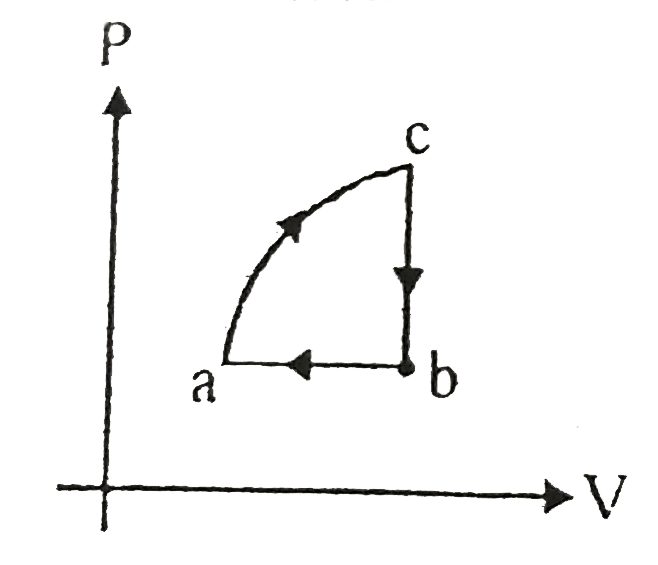In the given cyclic process from c to b 40 J heat is exchanged from b to a 130 J heat is exchanged and work done is 80 J from a to c, 400 J heat is exchanged, then:

Work done in process a to c is 310 J
Net work done in cycle is 230 J
Net change in internal energy in cycle is 130 J
Efficiency of cycle 57.5%
The correct Answer is:A, B, D
ΔUcycle=0
Qnet=Wnet
−40−130+400=Wcb+Wba+Wac
230=0+(−80J)+Wac
Wac=310J
Thermalefficiency=WorkoutputHeat∈put
=230400×100=11.5×5=57.5
Topper's Solved these Questions
- MASTER PRACTICE PROBLEMBOOK - BANSALCHAPTER - MASTER PRACTICE PROBLEMEXERCISE - Subjective
107 Videos
- MASTER PRACTICE PROBLEMBOOK - BANSALCHAPTER - MASTER PRACTICE PROBLEMEXERCISE - Additional topic
70 Videos
- MASTER PRACTICE PROBLEMBOOK - BANSALCHAPTER - MASTER PRACTICE PROBLEMEXERCISE - Reasoning
75 Videos
- FLUID MECHANICSBOOK - BANSALCHAPTER - FLUID MECHANICSEXERCISE - PYQS AIEEE
10 Videos
- SEMICONDUCTORSBOOK - BANSALCHAPTER - SEMICONDUCTORSEXERCISE - CBSE Question
32 Videos
Similar Questions
In a given system of unit standard measurement of mass is 100 gm standard measurement of length is 200 cm and standard measurement of time is 5 sec 10 J energy in the given system of unit has value N, then value of N is
View SolutionThe manifestation of band structure in solids is due to
View SolutionStatement-1: The numerical value (n)of a physical quantity is inversely proportional to size of unit (u) being used to measure it.
Statement-2:The magnitude of physical quantity does not change by changing the units.
View SolutionA cylinder of height 20m is completely filled with water. The velocity of effux of water (∈ms−1) through a small hole on the side wall of the cylinder near its bottom is
View SolutionHow does the width of the depletion layer of a p-n junction diode change with decrease in reverse bias?
View SolutionA system works in a cyclic process. It absorbs 20 calories of heat and rejects 60 J of heat during the process. The magnitude of work done (J) is [ 1 "calorie"=4.2 J] :
View SolutionIf change in internal energy -80 J. The work done by system is +40 J. Calculate the heat change.
View SolutionAn ideal gas undergoes a cyclic process as shown. Part of the process ab is isothermal expansion and work done by the gas in this expansion is 700 J. in adiabatic expansion be it again does 400 J work. If it rejects 100 J heat when it returns to a from c via b' then find efficiency of the cycle.
View SolutionIF 900 J/g of heat is exchanged at boiling point of water then increase in entropy is
View SolutionThe work done by a system is 8 J, when 40 J heat is supplied to it. The change in internal of the system during the process
View SolutionA heat engine is involved with exchange of heat of 1915 J , - 40 J , + 125 J and -QJ , during one cycle achieving an efficiency of 50.0 % The value of Q is:
View SolutionIn a cyclic process shown in the figure an ideal gas is adiabatically taken from A to B the work done on the gas during the process AtoB is 80 J, when the gas is taken from B to a the heat absorbed by the gas is 40 J. What will be work done by the gas in process BtoA ?
View SolutionIn a process, a system loses 125 J of heat when 400 J of work was done on the system. Calculate the change in internal energy.
View SolutionA heat engine is involved with exchange of heat of 1915 J , - 40 J , + 125 J and -QJ , during one cycle achieving an efficiency of 50.0% The value of Q is:
View SolutionThe work done by a system is 8 J, when 40 J heat is supplied to it. The change in internal energy of the system during the process:
View Solution
